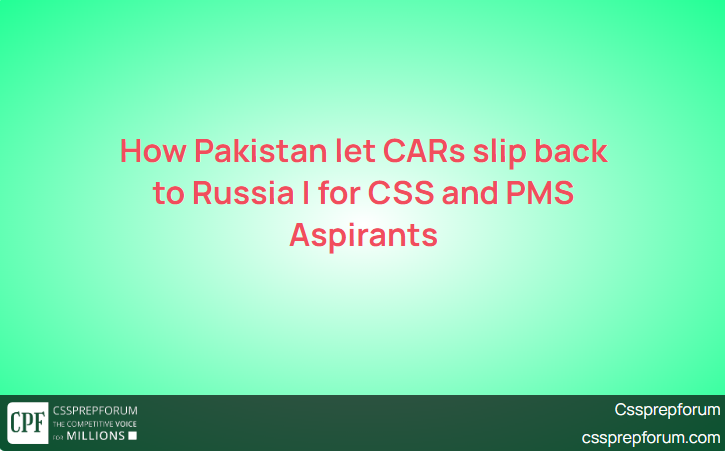Written by Mutahar Iftikhar
Pakistan, since its inception, has been a vulnerable state hedged between a hostile India and an antagonistic Afghanistan. Nonetheless, in 1990, there was a moment when Islamabad sought to expand its sphere of influence into Central Asia. The Soviet Union (USSR) had just collapsed, and communism was flowing out of Central Asia while Islam flowed in, so a power vacuum, almost the size of continental united states, emerged in the region. Keeping in mind that, centuries earlier, South Asia and Central Asia shared deep-running religious, political, cultural, and commercial ties, Pakistan took upon itself to revive those ancient links and reconfigure itself as a super-state, in the process.
When Pakistan declared itself an independent state in 1947, it reopened old questions concerning ethnic fault lines in South Asia. Across the border, Pashtun nationalists, immediately, looked to absorbed all the territories inhabited by their ethnic kin in Afghanistan’s kingdom. The Afghani Pashtuns favoured the idea of “Pashtunistan” and laid irredentist claims to the entire Pashtun populated area in Pakistan. Political tensions rose so severely that Afghanistan briefly blocked Pakistan’s admission into the United Nations. At the time of its creation, Pakistan was quite vulnerable, and the Afghanistan government started supporting Pashtun secessionist groups in the newly independent country. Its territory was divided into two non-contiguous parts while India laid claim to the Kashmir region. Had “Pashtunistan” formed; the provinces of Sindh and Baluchistan might have split as well. Whereas, Pakistan would have been reduced to the Punjab province, only. The stakes could not have been higher as the secessionist domino effect loomed over Pakistan. After a period of physical violence, embargoes, and political threats, relations eventually simmered when the Afghanistan Prime Minister, Daoud Khan, stepped down in 1963.

By the late 1960s, a new front emerged in east Pakistan, or modern Bangladesh, where social unrest transmuted into mass civil disobedience while the Bangladeshi lawmakers demanded greater autonomy from Islamabad. In consequence, the stand-off led to sporadic skirmishes between Pakistani government forces and Bangladeshi protesters. Pakistan, eventually, lost its hold over its eastern territories; thus, Bangladesh declared itself an independent sovereign state. Ironically, what was earlier believed to be a threat with “Pashtunistan” happened instead with Bangladesh; that proved the reality of the secessionist domino theory. Pakistan spent the next few decades working tirelessly on unifying its communities by crafting a national identity based on Islamic virtues. While secular ideas had failed earlier, faith’s appliance as a unifying component worked with remarkable success in Pakistan’s experience.
Only in the 1990’s did Pakistani lawmakers start thinking big and concentrate on their national identity. Nevertheless, two things had happened by that time: Afghanistan was in absolute chaos, and the USSR had broken up into smaller entities. In Central Asia, the former soviet socialist republics of Kazakhstan, Kyrgyzstan, Turkmenistan, Uzbekistan, and Tajikistan emerged as independent nations. Although each country had its own national symbols, centuries of Russian governance had eradicated any sense of cultural or national awareness. Once the USSR exited the scene, and the communist influence evaporated, historical memories surfaced. Apart from Tajikistan, all Central Asia was home to Turkish speaking ethnicities, for all of them had been an integral part of the Muslim world. So, when the USSR, with its communist ideology, collapsed, the top communist officials refurbished themselves, as the new founding fathers. The former communist strongmen became despots. To consolidate their hold on power, they erected statues of themselves and designated their birthdays as national holidays by putting up billboards of themselves all over the new territories.

In a space devoid of national identity and ideology, the communities in Central Asia were desperate to believe in something. Islam filled that need, just as it had in Pakistan, and there was a strong case for faith to flourish, too. In ancient times, Central Asia was often referred to as the horizon where powerful Turkish kings, mercenaries, and warlords roamed the plains searching for bounty and conquest. Some of them had travelled west, like Timur, while others had set their sights to the south, like Babur, who founded the Mughal empire. Either way, Central Asia was deeply tied to the Middle East’s history and the Indian sub-continent. Now, the communities in Kazakhstan, Kyrgyzstan, Turkmenistan, Uzbekistan, and Tajikistan, however, were sole searching for cohesive social meaning. Ordinarily, the world would have left them alone, but in the 1990s, geological surveys calculated that the Caspian Sea basin holds a tremendous hydrocarbon reserve, second only to the Persian Gulf region. The discovery elevated Central Asia’s status to an energy store-house. There was just one problem; Turkmenistan, Kazakhstan, and Uzbekistan, the nations that inherited the hydrocarbon wealth were landlocked. Meanwhile, Turkey, Iran, and Pakistan were the first to recognize Central Asia’s cultural flux and energy wealth as a power vacuum, and they also happened to be the only routs capable of delivering the regional hydrocarbons to the industrialized world. Hence, in 1992, Ankara, Tehran, and Islamabad revived and expanded the Economic Cooperation Organization (ECO) to include five Central Asian republics. The immediate goal was to create new pipelines and to introduce a common market for goods and services across the region, and strategic realignment of the block was the long-term objective.
Ankara explored many ways to promote pan-Turkic ideas. Although most of the Central Asian republics were Turkic, the sheer distance between turkey and CARs put an end to this plan. Tehran meanwhile took an interest in promoting its deep historical ties to Central Asia; however, the vision also ended abruptly because Iranian adhered to a different branch of Islam. In the scramble, Pakistan was naturally left as the only potential power broker in the race for Central Asia, and Pakistan did meet much of the criteria: It adhered to Sunni Islam, it was in the immediate vicinity, it shared cultural commonalities, and like Central Asia, Pakistan had done some sole searching as well. So, it knew how to construct social cohesion and possibly how to melt Central Asia with Pakistan.

Appreciating the historical opportunity, euphoria overcame Islamabad. Suddenly, Pakistan seemed as it was about to emerge a heavyweight in global politics. If Islamabad could get some trade deals going with Central Asia, it could cement its foothold. In 1992, Pakistan tended about 10 million dollars in credit to Kazakhstan, Kyrgyzstan, and Tajikistan to establish joint ventures in cotton, textiles, pharmaceuticals, telecommunications, and agriculture, and it also signed a deal with Uzbekistan to construct highways and manufacturing plants. With Tajikistan and Kyrgyzstan, Pakistan signed agreements to import hydroelectric power and pledged to bolster the reach of the English language in banking, accounting, insurance, and diplomacy etc. The initial projects ranged from trade and science to education and tourism; the icing on the cake was the Turkman-pipeline, which stretched from Turkmenistan to Karachi’s Pakistani port from where tankers could ship the crude oil anywhere else in the world. The technical specification of the plan was simple. Because it bypassed both Iran and Russia, the venture easily met the approval of Washington. It was believed that this pipeline would have granted Pakistan significant influence over Central Asia allowing Islamabad to promote its commercial interests and gradually solicit the region into its sphere of influence. In just a few decades, Islamabad’s authority would have stretched from Siberian planes of Kazakhstan to the tropical coastline by the Arabian Sea. Not only would Pakistan have gained enormous strategic depth but also have received a heavy boost to its manpower, resources, logistics, funding, etc. The assets would have levelled the playing field with India, and that was an objective worth-pursuing, indeed.
There was just one complication the Turkman-pipeline, the primary project towards a Pakistani hegemon, would have to go through the lawless domain of Afghanistan. Not only did Afghanistan share a common border with Turkmenistan, Uzbekistan, and Tajikistan, but it also provided a direct route for the road, rail, and air traffic. On the face of it, constructing a pipeline across one of the most chaotic places on earth seems irrational. However, the opportunity of a Pakistan that could match India in its resources and capacity was the one that Pakistanis could not let slide. It was a short in the dark but an opportunity, nonetheless. One thing was certain that going into Afghanistan, Pakistan had long term strategic interests that were shaped by the factors, forces, and considerations beyond Afghanistan itself. The Pakistani intelligence agency, ISI, believed that it could be done. Afghanistan could be subjugated, and all they had to do was to create a corridor linking Central Asia to South Asia.
When it became evident that the Pakistani proxy groups could not deliver either of the corridors, Islamabad began supporting newly emerging Taliban from 1994 onwards. That turned out to be a disaster as the Taliban aggravated the endemic violence in Afghanistan. Then, they turned against Pakistan by refusing to recognize the Durand Line as an international border and effectively reviving the idea of a unified “Pashtunistan”. On the top of it, the rise of Taliban stimulated jihadist movements across the periphery including the newly independent Central Asian Republics as Islamic militias popped up in Uzbekistan, Kyrgyzstan, and Tajikistan. If jihadism was Pakistan’s idea of social cohesion, Central Asia would have none of it, then. Tashkent officials accused their Pakistani counterparts of training Uzbeks jihadists, and they deliberately reduced political and economic relations. The other countries followed suit; Central Asia’s honeymoon with Pakistan collapsed soon after. To seal the deal, many of the Central Asian Republics (CARs) choose to reestablish security ties with Russia. By the turn of the millennium, Islamabad’s vision for a superstate perished in its cradle; the rest is history. Humbled by its past failures, Pakistan today pursues a more modern policy. Karachi and Gwadar’s deep-water ports serve as ideal shipping hubs providing the landlocked CARs, Afghanistan, and even china’s Xinjian region with much-needed access to the Arabian Sea. After all, political power without economic power is just sterile; therefore, shifting the focus to its territory makes a whole lot more sense for Pakistan.

About the writer:
Mutahar Iftikhar, an engineer and an ardent CSS aspirant, writes on a range of topics pertaining to competitive examinations and has also completed his creative writing course from Sir Syed Kazim Ali.
Name of the Student: Mr Mutahar Iftikhar
Qualifications: Petroleum Engineering
Total Articles/Blogs: 2
English Coach: Sir Syed Kazim Ali
Course Taken: Creative English Writing & Article Writing
Like other competitive students, If you have a story to tell, guidance to help, knowledge to educate, or a perspective that can help CSS aspirants daily, welcome to CSSPrepForum. It is free to get your opinions, viewpoints, judgements, and thinking published, whether it is a blog, article, essay, application, letter, precis, comprehension, MCQs, or anything that helps competitive youth of Pakistan. CSSPrepForum is a place that let you connect with thousands of competitive readers, and helps your voice heard across the community. Let’s start writing and get your voice heard to those who are looking for you. Email Your Write-ups at csspreps@gmail.com
CSS 2022 Solved Pakistan Affairs Past Papers
The following are the CSS 2022 Pakistan Affairs solved past papers questions. These questions have been evaluated and checked by Pakistan’s top Pakistan Affairs and Current Affairs coaches, who are either lecturers or officers and scored the highest marks in this paper. They include Miss Saba Baloch (CSS-2021), Miss Aimeen Mirza (CSS 2018), Miss Nirmal Hasni (DD NAB), Sir Rameez Ch. (Lecturer & Deputy Director), and Miss Zaineb Azam (the highest scorer – 76). Moreover, these questions have been attempted on the same pattern taught by Sir Syed Kazim Ali to his students who have been scoring the highest marks for years.
CSS 2021 Solved Pakistan Affairs Questions

More Essays
- Meaning Purposive Education
- Bureaucracy Doldrums
- Is Gender Equality a Myth?
- Pros and Cons of Globalization for Pakistan
- Islamophobia: Causes and Consequences
- Artificial intelligence: Its Merits and Demerits
- IMF Bailouts: Roads to Stability or Recipes for Disaster
- Can Foreign Aid Help A Country Achieve Economic Stability?
- Consequences of American Withdrawal from Afghanistan on South Asia
- Money And Success Do Not Change People; They Merely Amplify What Is Already There
- Almost Always, The Creative, Dedicated Minority Has Made The World Better












